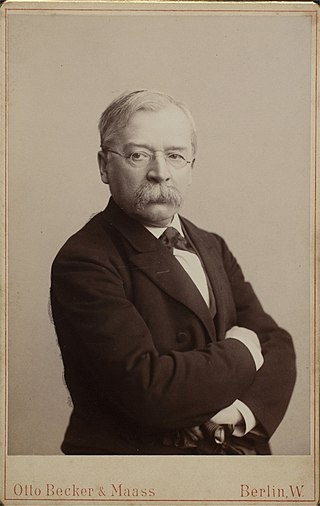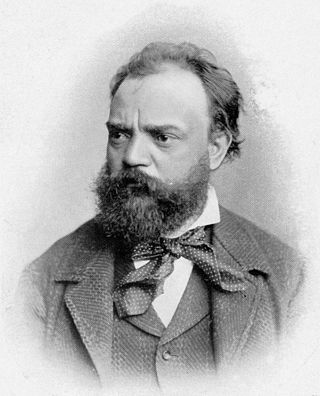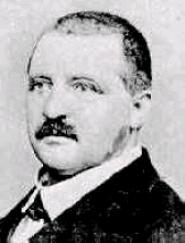Sources
- Rijen, Onno van. "Opus by Miaskovsky". Archived from the original on 13 May 2014. Retrieved 11 January 2010.
Nikolai Myaskovsky wrote his Symphony No. 8 in A major, his Opus 26, between 1924 and 1925.
The symphony is his second in the major - the first is his fifth symphony - and the premiere was conducted by Konstantin Saradzhev, who had premiered the composer's fourth and seventh symphonies. It is dedicated to Sergei S. Popov.
It is in four movements:

A string orchestra is an orchestra consisting solely of a string section made up of the bowed strings used in Western Classical music. The instruments of such an orchestra are most often the following: the violin, which is divided into first and second violin players, the viola, the cello, and usually, but not always, the double bass.

Hugo Emil Alfvén was a Swedish composer, conductor, violinist, and painter.

The Symphony No. 2 in D major, Op. 36, is a symphony in four movements written by Ludwig van Beethoven between 1801 and 1802. The work is dedicated to Karl Alois, Prince Lichnowsky.

Asger Hamerik (Hammerich) was a Danish composer of the late romantic period.
The Young Person's Guide to the Orchestra, Op. 34, is a 1945 musical composition by Benjamin Britten with a subtitle Variations and Fugue on a Theme of Purcell. It was based on the second movement, "Rondeau", of the Abdelazer suite. It was originally commissioned for the British educational documentary film called Instruments of the Orchestra released on 29 November 1946, directed by Muir Mathieson and featuring the London Symphony Orchestra conducted by Malcolm Sargent; Sargent also conducted the concert première on 15 October 1946 with the Liverpool Philharmonic in the Philharmonic Hall, Liverpool, England.

Woldemar Bargiel was a German composer.

Bernhard Heinrich Romberg was a German cellist and composer.

The Symphony No. 1 in B♭ major, Op. 38, also known as the Spring Symphony, is the first completed symphonic work composed by Robert Schumann.

Pyotr Ilyich Tchaikovsky's Piano Concerto No. 3 in E-flat major was at first conceived by him as a symphony in the same key. But he abandoned that idea, jetisoned all but the planned first movement, and reworked this in 1893 as a one-movement Allegro brillante for piano and orchestra. His last completed work, it was duly published as Opus 75 the next year, after he died, but given by publisher Jurgenson the title "Concerto No. 3 pour Piano avec accompagnement d'Orchestre".

The Symphony No. 5 in F major, Op. 76, B. 54, is a classical composition by Czech composer Antonín Dvořák. It was originally published as Symphony No. 3.
An organ concerto is a piece of music, an instrumental concerto for a pipe organ soloist with an orchestra. The form first evolved in the 18th century, when composers including Antonio Vivaldi, George Frideric Handel and Johann Sebastian Bach wrote organ concertos with small orchestras, and with solo parts which rarely call for the organ pedal board. During the Classical period the organ concerto became popular in many places, especially in Bavaria, Austria and Bohemia, reaching a position of being almost an integral part of the church music tradition of jubilus character. From the Romantic era fewer works are known. Finally, there are some 20th- and 21st-century examples, of which the concerto by Francis Poulenc has entered the basic repertoire, and is quite frequently played.
Frédéric Chopin's Allegro de concert, Op. 46, is a piece for piano, published in November 1841. It is in one movement and takes between 11 and 15 minutes to play. The principal themes are bold and expressive. It has a curious place in the Chopin canon, and while its history is obscure, the evidence supports the view, shared by Robert Schumann and others, that it started out as the first movement of a projected third piano concerto, of which the orchestral parts are either now non-existent or were never scored at all. There is no evidence that Chopin ever even started work on the latter movements of this concerto.
The Overture, Scherzo and Finale in E major is a work for symphony orchestra by Robert Schumann. It is his opus 52, and was written in 1841. Schumann originally considered it his second symphony. The Overture, Scherzo and Finale was received tepidly by critics, was revised in 1845 and published the next year, with a dedication to Johannes Verhulst.

The Symphony No. 2 in F minor was written by Richard Strauss between 1883 and 1884. It is sometimes referred to as just Symphony in F minor. He gave it the Opus number 12, and it also appears in other catalogues as TrV 126 and Hanstein A.I.2. It is not listed in von Asow's catalog.
Nikolai Myaskovsky's Symphony No. 20 in E major, his Op. 50, was written in 1940. It is dedicated to Yuri Shaporin. The symphony was premiered on 28 November 1940 by Nikolai Golovanov conducting the Large All-Union Radio SO. It has three movements:

The Symphony in D minor, WAB 100, was composed by Anton Bruckner in 1869 between Symphony No. 1 (1866) and Symphony No. 2 (1872). In 1895 Bruckner declared that this symphony "gilt nicht" and he did not assign a number to it. The work was published and premiered in 1924.